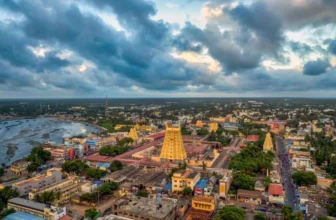❄️ The Japanese Yukimi Onsen: Bathing in Snow for Warmth and Wellness
Introduction
Imagine soaking in a steaming hot spring, surrounded by snow-covered mountains and falling flakes. This serene, almost poetic image is real—and deeply rooted in Japanese tradition. Known as Yukimi Onsen (literally “snow-viewing hot spring”), this seasonal ritual blends nature, culture, and science into an unforgettable winter experience.
But beyond the breathtaking scenery, what makes this winter bath so beneficial? The science behind it might surprise you.
🏔️ What is Yukimi Onsen?
Yukimi Onsen is the practice of bathing in outdoor hot springs while watching the snow fall, typically during Japan’s winter months (December to February). Found in mountainous regions like Nagano, Hokkaido, and Tohoku, these open-air baths offer a contrast of extreme temperatures—hot mineral-rich water against icy surroundings.
It’s not just about beauty. It’s a deeply relaxing and often spiritual moment that reflects Japan’s cultural reverence for seasonal change, known as “kisetsukan” (季節感).
🧖♀️ Cultural Significance
- Harmony with Nature (Shizen to no chōwa)
Japanese culture emphasizes living in balance with nature’s rhythms. Yukimi Onsen offers a physical and mental space to reflect on the quiet stillness of winter—a time for slowing down and recharging. - Onsen Etiquette and Rituals
Before entering an onsen, bathers cleanse themselves, symbolizing not only physical hygiene but also a form of purification—a practice influenced by Shinto traditions. - Mindfulness and Simplicity (Wabi-sabi)
The minimalism and tranquility of sitting in hot water while observing snow capture the wabi-sabi philosophy: finding beauty in simplicity, impermanence, and imperfection.
🧪 The Science Behind the Soak
Hot springs in Japan are not just warm—they’re mineral-rich and geothermally heated from volcanic activity. Here’s how they affect the body:
1. Thermal Contrast Therapy
The juxtaposition of hot water and cold air triggers a form of contrast hydrotherapy, which:
- Improves circulation: Blood vessels expand in warm water, then constrict in cold air, improving vascular flexibility.
- Reduces inflammation: The cold exposure can reduce joint swelling and ease sore muscles.
- Stimulates endorphins: The contrast activates the sympathetic nervous system, boosting mood and alertness.
2. Mineral Benefits
Japanese onsen waters often contain:
- Sulfur: Good for skin and antibacterial properties.
- Calcium and Magnesium: Help with muscle recovery and skin hydration.
- Sodium chloride: Keeps the body warm by forming a salt layer on the skin that retains heat.
3. Mental Health Effects
Research in Japan has shown that regular hot spring bathing:
- Reduces stress hormone cortisol
- Improves sleep quality
- Lowers symptoms of anxiety and mild depression
🌍 Similar Practices Elsewhere
While Yukimi Onsen is uniquely Japanese in spirit, similar winter bathing customs exist around the world:
- Nordic countries alternate between hot saunas and snow or ice baths.
- Russian banya bathers roll in snow or ice after steam rooms.
- Icelanders regularly soak in geothermal hot springs like the Blue Lagoon year-round.
Each of these practices uses the body’s natural responses to temperature to promote resilience and recovery.
🧘♂️ Conclusion: A Soak for the Soul
Yukimi Onsen isn’t just about keeping warm—it’s a profound seasonal ritual rooted in culture and powered by science. It shows us how slowing down and tuning into nature, even in the coldest months, can bring warmth not only to the body—but to the spirit.
In a world full of rushing and noise, perhaps the best therapy is a quiet bath in falling snow.










